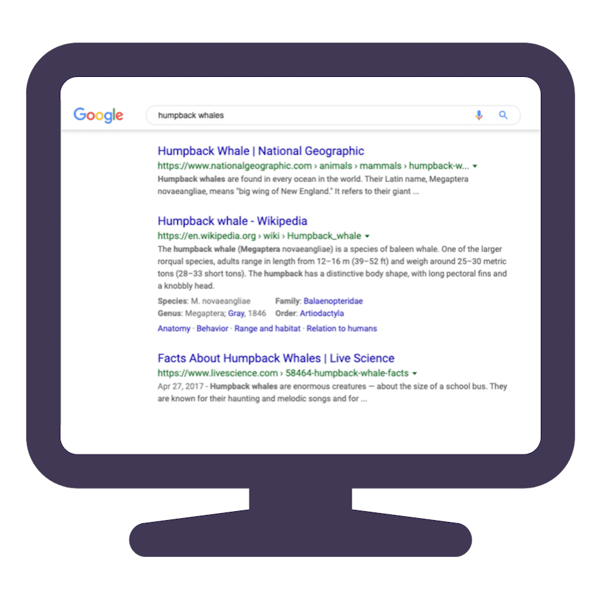Essential SEO Tips for Nonprofits

Let’s say you’re curious to learn more about humpback whales. Chances are, you’ll head to the Google machine or favorite search engine to begin your research. You might want to know about where humpback whales live, interesting facts about humpback whales, and ways you can support their survival. Depending on what you search, varying articles and websites will appear. Eighty percent of visitors never get past the first page of Google, so if you’re not finding what you’re looking for, you will likely change the keywords you search to refine your results instead of heading to page two.

Prospective supporters follow this same search path. To ensure they can find your organization organically (not through paid ads), your nonprofit must have smart SEO tactics in place. SEO stands for Search Engine Optimization, which can be translated to “showing up on Google’s search results.”
You likely understand your organization’s purpose and its value proposition, but does Google? The higher your ranking on Google, the greater likelihood potential supporters will land on your website and learn about your organization. This blog walks you through what SEO is, short-term and long-term techniques your nonprofit can implement to improve SEO, and why it matters. Leave room for our free downloadable checklist after you've digested these tips. Let’s dive in.
Get Down to Basics
In order for your organization’s website to rank highly, you need to build trust with Google. Trust and authority is built over time. No one achieves good SEO overnight, but as you consistently incorporate smart SEO strategies, your ranking will continue to improve.
There are ten major factors that Google considers when determining your site ranking. Here’s a snapshot:
- Site Age → How long your website domain has been around. If your organization is newer, then this factor will take time to grow.
- Active Content → do you keep your website updated? Are you posting content consistently?
- Load Times → How long it takes for your website to load. This free resource evaluates your website load time for free and gives a grade.
- Backlinks → A key indicator to whether your website is trusted or not. How does your website interact with other websites on the internet? Are people sharing a link to your website from other trusted websites? For example, if a link to your nonprofit website is included in a story by the New York Times (an old, trusted website), that increases trust of your own website through a high-quality backlink. Check your backlink score for free here!
- Social Interaction → Are supporters sharing your content? Website data can be shared through social media and help impact conversions when you have an active social presence.
- Search Relevance → Are the keywords associated with your website relevant in Google? Meaning, are they searched for in other capacities?
- Traffic → Does your website receive consistent traffic?
- Security → Is your website secure? Do you have the added security of “https” in your url?
- Direct Google Searches → How frequently do users find your website when searched verbatim? For example, if your organization is called Humpback Whales Society, are people finding your website through those keywords?
- Click-Through + Bounce Rate → How long people stay on your website, how they interact with resources, and how soon they leave.
That’s a whole lot to consider when building trust with Google. So let’s boil it down. The end game to improving your SEO is to become easily searchable for supporters new and old. The more factors you incorporate into your strategy, the higher your website will rank in Google. No need to drop everything and leverage all of these points at the same time - SEO is a long game. Start small, asses, and adjust.
Start Simple
Consider what sets your nonprofit organization apart, and begin to incorporate keywords into your landing pages that highlight exactly who you are. Your homepage is a prime location to give Google (and new visitors) a snapshot of your mission - and this is what Google reads first. Choose targeted, specific keywords and keep it to a minimum. Work your keywords into your value proposition, headline, and corresponding urls. Remember that you’re also writing for humans to read, so don’t shove keywords all over the place willy-nilly. Work your targeted keywords into your webpages as naturally as possible.
Resources like Moz and SEMRush can help grant a better idea of the keywords your nonprofit should be targeting to rank highly.
Let’s explore Girls Inc. of the Pacific Northwest for a snapshot of good keyword usage. On their homepage, the keyword “girls” appears 52 times. That gives Google a pretty good idea of what Girls Inc. is all about - in case the name of their organization didn’t give it away.
The keyword “girls” is found:
- In the URL: girlsincpnw.org
- In the title text : “Inspiring all girls to be strong, smart, and bold.”
- In the meta description: “Girls Inc. opens opportunities to girls today while making our society more equitable for all girls.”
- In content headers: “Girls Inc. is prepared and dedicated to addressing the complex challenges girls face while leveraging the diverse capabilities of girls today.”
While the keyword appears all over their homepage and throughout their website, it is used strategically - woven into their language so it feels natural and programmatic. SEO is largely a balance between smart strategy and user experience, so make sure your use of a targeted keyword doesn’t detract from your overall website experience.
Effective use of targeted keywords can help to improve active content, backlinks (do other websites share your landing pages?), social interaction, search relevance, and direct Google searches.
Content Curation & Backlinks
In 2019, content still reigns queen. What search engines care about is whether the content you’re producing is shareable. In order to determine whether your content is shareable, search engines ask the following questions:
- Is your content generating traffic?
- Are other trusted websites (New York Times example) sharing your webpages?
- Does your content include focus keywords and phrases?
- Are visitors sharing your landing pages on social media?
One of the most important pieces to content curation is high-quality backlinks. Backlinks are created when one website links to another, and are the number one ranking factor for SEO. To be relevant in Google, your website needs to have a balance of trust and authority, and backlinks essentially vet your organization as trustworthy. Backlinks matter because they grant authority to your domain over time. If backlinks were a conversation, it would feel something like this:
Oh yeah, Habitat for Humanity? They totally know what they’re talking about, Google says. How does Google know, you ask? Well, because all these other websites and shared social media posts say so! Their website is shared by tons of trusted websites - over a million to be precise. Thanks to a smart use of SEO, Habitat for Humanity is easy to find and benefits from high website traffic as a result.
Key Takeaways
This is just a snapshot of a few SEO strategies - there’s a lot more meat to this conversation. For now, we’ll keep it simple. In order to see results, application is everything! Just reading this blog is not enough to improve your website’s SEO, though that would be nice.
To recap: incorporate target keywords naturally, create shareable content, and begin a backlinks building strategy. Investing in SEO over time aims to improve your search engine ranking, generate more website traffic, and ultimately, result in more conversions.



